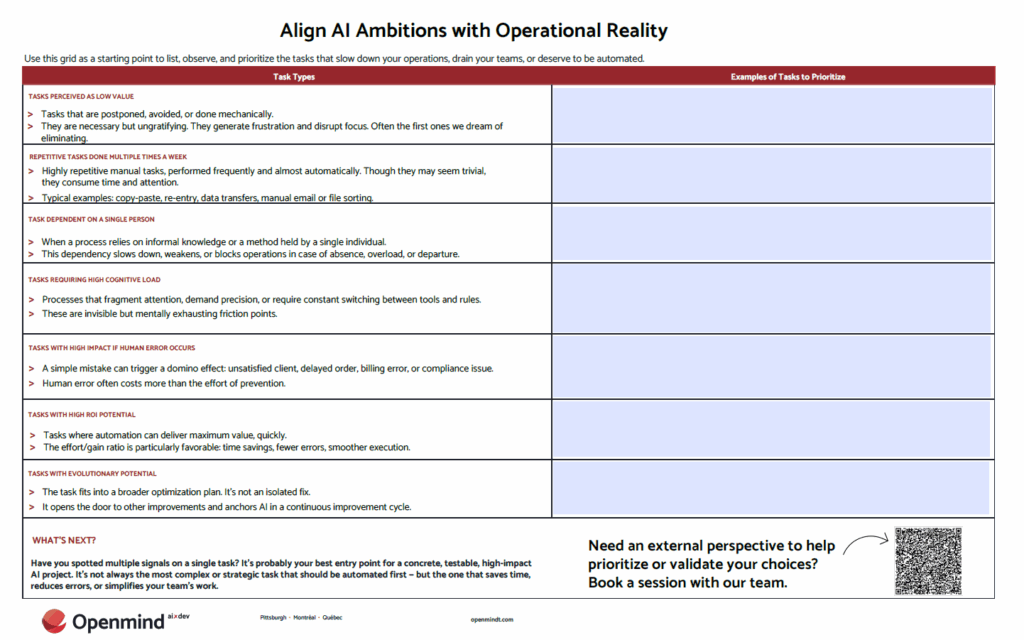Prioritize the right tasks to make your AI project successful
Spot the right tasks. Unlock real impact. Build AI use cases that matter for your business.

On September 24 and 25, Montréal established itself as the epicenter of North American artificial intelligence during the ALL IN AI 2025 summit. Researchers, founders, decision-makers, and influencers outlined the key directions of our technological future, from Québec to the international stage.
One certainty emerged: AI is no longer optional, it is THE essential pillar of competitiveness.
Behind ambitious promises and spectacular demonstrations, the reality is more nuanced: many pilot projects fail, Canadian SMEs struggle to keep pace, and trust around data remains hesitant.
However, the conference also revealed a clear trajectory: wherever governance is strong, experimentation is encouraged, and data quality is guaranteed, transformations materialize through increased productivity and measurable results that become real advantages.
To help you move from theory to action, here are the 8 essential strategies from ALL IN AI 2025.
Recommendations to implement now to secure your competitive edge and navigate the AI future from a position of strength.
1. AI is everywhere, and the pace is accelerating
Today, AI is no longer a concept of the future — it’s operating concretely. From banking institutions to aerospace to logistics, AI is no longer a prototype: it’s operational.
With AI, waiting means falling behind.
AI now ranks among the essentials, like electricity or the internet: in just a few years, it will be the standard adopted by all. The real advantage? Seizing AI now to widen the gap before your competition catches up.
Identify one task or process that could be optimized with AI. Launch a pilot project, track progress, and showcase the gains: every day lost deepens the gap with your competitors.

Spot the right tasks. Unlock real impact. Build AI use cases that matter for your business.

The main barrier to AI adoption in Canada isn’t technology, it’s culture. Too many companies remain paralyzed, fearing failure or missteps.
“This ability to test quickly is one of the most important elements. Then, the day we’re confident we’re heading in the right direction, we can move to the MVP and scale production more widely. The idea is to go very quickly back and forth: if it doesn’t work, I want very few people involved, low cost, and fast execution.
And the higher the velocity, the more we can capture, demonstrate value, and move forward as an organization.”
— Panel, iA Financial GroupOne striking case: a major Canadian organization went through a chaotic journey with its AI agents and OCR. What seemed like a string of failures turned into a major competitive advantage thanks to a structured “sea of data.”
Pioneers are rarely the ones who plan perfectly, but those who accept discomfort and turn failure into learning.
Host a “Right to Try” workshop in your company. Share a failure openly, analyze it as a team, and identify the innovation opportunities it can generate. Boldness isn’t optional: it’s the key to gaining a real edge.
Flashy demos impress, but measurable results move organizations forward. What matters are precise, quantified outcomes.
The “wow” factor gets attention… but the real gains — time saved, costs reduced, humans empowered — are what truly transform organizations.
This year, identify (and measure) just one process to optimize. Document your results (time, cost, quality). Share this data with your team and highlight the impact with your clients and partners.
4. Impact is built through iteration
BDC shared a troubling observation: Canadian SMEs lag when it comes to going beyond basic generative AI use.
The main brake? Distrust.
Organizations that advance choose agility.
AI isn’t a one-off project. It’s a living process, fueled by trials, failures, learnings, and documented wins.
Focus on mini AI pilots. Dare to test small, track results, and document every iteration. Learn from failures as well as successes, and make the improvement cycle an integral part of your digital strategy.
Automation, significant time savings, and error reduction for a promotional products company.

One striking figure from ALL IN AI: 95% of pilot projects fail due to unreliable data.
Without strong governance and traceability, no AI moves from experimentation to production.
In Québec, this becomes a strategic lever: digital sovereignty. Companies that master their data (location, compliance, access) build client and partner trust faster.
Security, governance, sovereignty: the trio of sustainable competitiveness.
Audit your data management: check location, access, and compliance. Modernize practices to ensure traceability and security, then share your progress within your network. Trust is built on concrete actions.
AI success never happens in isolation. A few examples:
Innovation moves at the speed of the network. Leaders are those who mobilize, activate collective strengths, and build bridges across sectors.
Join a collaborative AI initiative. Identify partners, propose a workshop (like Openmind’s roundtables 😉), or join a sectoral group. The more you open up, the faster your organization accelerates toward digital automation and positions itself as an essential ecosystem player.

Today, only pioneers are taking advantage of it. Within 3 to 7 years, AI will be standard. The real benefit? Taking advantage of it before others do.
The school system is struggling to keep pace: too many new graduates enter the job market without real AI preparation.
That means companies must step up to fill the gap and build their own expertise. They must:
The key skill of the future is no longer static knowledge. What truly drives progress is the ability to learn continuously, adapt, and evolve with the tech landscape.
Establish an AI learning routine. Each month, organize an internal workshop where team members present a tool, a use case, or a new idea. Encourage mentorship and peer learning to build a genuine culture of continuous progress.
At the heart of every technological breakthrough are committed humans.
AI should never be seen as a substitute for talent. It’s an amplifier, enhancing potential and expanding the impact of humans in every team.
Make humans your priority. Run an internal survey on expectations, concerns, and inspirations related to AI. Encourage idea sharing and create a space where initiative, openness, and skill development are celebrated.
The ALL IN AI 2025 summit confirmed it unequivocally: AI is now a strategic reality shaping the future of organizations.
Together, these announcements confirm what ALL IN AI revealed: the time to act is now.
One question remains for most organizations: will you wait until AI becomes the norm, or seize the opportunity to stand out today — gaining the advantage while it’s still within reach?
Subscribe to receive our exclusive updates directly to your email.

Tell us more about your needs so that we can better route your project to our specific SWAT team.
1
During the brainstorming phase, we work with you to identify potential solutions to your business challenges to generate the technology response that aligns with your business objectives.
2
Through our requirements gathering process, we work closely with you to define and prioritize your needs, ensuring that our solutions are tailored to meet your specific requirements.
3
This phase marks the beginning of our partnership. We’ll finalize the project plan and establish clear communication channels to ensure a smooth and successful project execution.